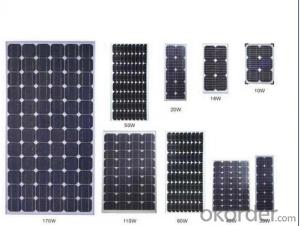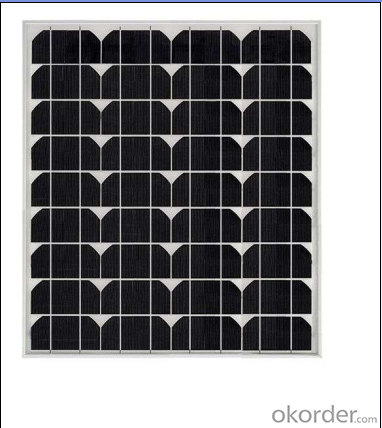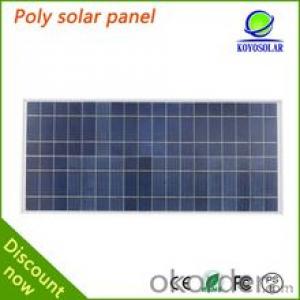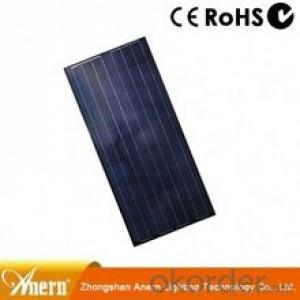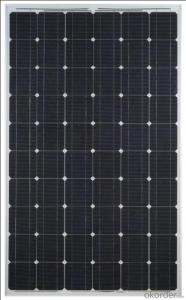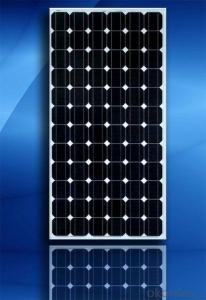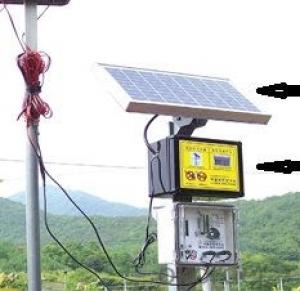Rec Solar Cells Monocrystalline Solar Cell Price with 25 Year Warranty CNBM
- Loading Port:
- Qingdao
- Payment Terms:
- TT OR LC
- Min Order Qty:
- 10 pc
- Supply Capability:
- 300000 pc/month
OKorder Service Pledge
OKorder Financial Service
You Might Also Like
Quick Details
| Place of Origin: | China (Mainland) | Brand Name: | cnbm | Model Number: | PS-M672300 |
| Material: | Monocrystalline Silicon | Size: | 1956*990*40mm | Number of Cells: | 72 pieces |
| Max. Power: | 300W | Weight: | 23kg monocrystalline solar panel | Product warranty: | 25 years |
| Maximum system voltage: | 1000VDC | Tolerance: | 0/+3% | Cable length: | 1.2m |
| Connector: | MC4 compatible connector | Junction box: | IP65 Rated | Frame: | Anodized aluminium alloy |
| Front Cover: | 3.2mm thick.low iron tempered glass | Cell type: | Monocrystalline solar panel cells 156mm |
Packaging & Delivery
| Packaging Detail: | Monocrystalline solar panel packing information 28pcs. / box 20pcs. / pallet 560 pcs. / 40ft 602 pcs. / 40ft (H) |
| Delivery Detail: | in one week |
Specifications
1. Best monocrystalline solar cell price
2. 300W Monocrystalline solar panel with best price
3. 25 years warranty
Product Name
High Efficiency monocrystalline solar cell price with 25 year warranty
Product Description
1.Solar Panel Descprition
PS-M672 Series solar panel is connected in series by 70 pieces of 156mm×156mm Mono Crystalline silicon cells. Solar panel performance is produced according to IEC61215, IEC61730 international standard.
2.Solar Panel Characteristics
1)Manufactured according to international quality and Environment Management
System (ISO9001, ISO14001)
2)High efficiency crystalline silicon solar cells
3)High transmission Iow iron tempered glass, strong mechanical resistance
4)Anti-ageing EVA and excellent anti-climate back sheet
5)Anodized aluminum frame improves load resistance capabilities for heavy wind loads.
6)Standard waterproof junction box
7)High endurance to different weather
8)Good and friendly package with less transportation and storage space.
3.Solar Panel Warranty
1)10 years limited manufacturing warranty
2)10 years for 90% of warranted minimum power
3)25 years for 80% of warranted minimum power
4.Solar Panel Electric Characteristics
| Cell Type | Mono Solar Cell 156mm*156mm | |||
| Item | PS-M672285 | PS-M672290 | PS-M672295 | PS-M672300 |
| Power | 285W | 290W | 295W | 300W |
| Voc(V) | 44.8 | 45 | 45.3 | 345.5 |
| Isc(I) | 8.6 | 8.75 | 8.85 | 8.95 |
| Vm(V) | 36.2 | 36.3 | 36.5 | 36.6 |
| Im(I) | 7.87 | 7.99 | 8.08 | 8.20 |
| Cell Efficiency | 17.08 | 17.38 | 17.68 | 17.98 |
| Module Efficiency | 14.72 | 14.98 | 15.23 | 15.49 |
| Fuse | 15A | |||
| Max System Voltage | 1000VDC | |||
| Cell Number | 72cells | |||
| Tolerance | 0/+3% | |||
| Module Size | 1956*990*40(mm) | |||
| Weight | 23KGS | |||
| Cable Length | 0.9m | |||
| Connector | MC4 or compatible connector | |||

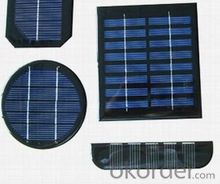
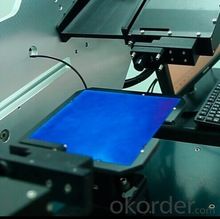
- Q: What is the difference between polysilicon and monocrystalline silicon photovoltaic cells?
- Monocrystalline silicon cells with high battery conversion efficiency, good stability, but the higher cost. Polycrystalline silicon cells are less costly and slightly lower in conversion efficiency than straight-drawn monocrystalline silicon solar cells, with various defects in materials such as grain boundaries, dislocations, microdefections, and impurity carbon and oxygen in materials, as well as tarnished during process Transition metal.
- Q: Can solar cells be used to power security systems?
- Yes, solar cells can be used to power security systems. Solar cells convert sunlight into electricity, which can be stored in batteries for continuous power supply. This makes solar cells an ideal and sustainable solution for powering security systems, especially in remote or off-grid locations where access to grid electricity may be limited.
- Q: Are there any books in the market t about solar cells and their applications?
- The solar was used in the SwissTech Convention Center.
- Q: How are solar cells connected in a solar panel?
- Solar cells are connected in a solar panel through a series of electrical connections, typically using metal conductors, to form an array. These connections allow for the flow of electric current generated by individual solar cells, which are usually made of silicon-based semiconductors, to be combined and harnessed as usable electricity.
- Q: Do you believe you can make a solar cell by using kitchenware?
- No, I don't believe it at all.
- Q: Can solar cells be used in clothing?
- Yes, solar cells can be used in clothing.
- Q: Can solar cells be used in public transportation systems?
- Yes, solar cells can be used in public transportation systems. They can be integrated into various components such as the roof or windows of buses, trains, or trams to harness solar energy and power the vehicle's electrical systems, reducing reliance on fossil fuels and lowering carbon emissions. This technology is already being implemented in some cities around the world, offering a more sustainable and environmentally friendly alternative for public transportation.
- Q: How are solar cells used in calculators?
- Solar cells are used in calculators to convert sunlight into electrical energy, which powers the device and allows it to function without the need for batteries or external power sources.
- Q: Can solar cells be used in residential applications?
- Yes, solar cells can be used in residential applications. In fact, they are increasingly being utilized in homes as a renewable and sustainable source of energy. Solar panels can be installed on rooftops or in yards to convert sunlight into electricity, reducing dependency on traditional power grids and lowering energy costs for homeowners.
- Q: How do solar cells perform in cloudy weather?
- Solar cells still generate electricity in cloudy weather, but their performance is reduced. Cloud cover reduces the amount of sunlight reaching the cells, resulting in decreased power output.
Send your message to us
Rec Solar Cells Monocrystalline Solar Cell Price with 25 Year Warranty CNBM
- Loading Port:
- Qingdao
- Payment Terms:
- TT OR LC
- Min Order Qty:
- 10 pc
- Supply Capability:
- 300000 pc/month
OKorder Service Pledge
OKorder Financial Service
Similar products
Hot products
Hot Searches
Related keywords
